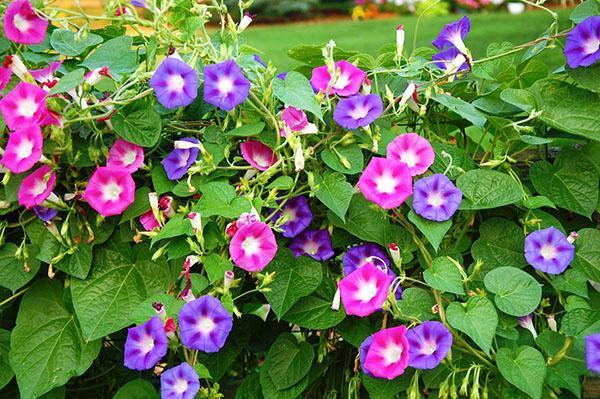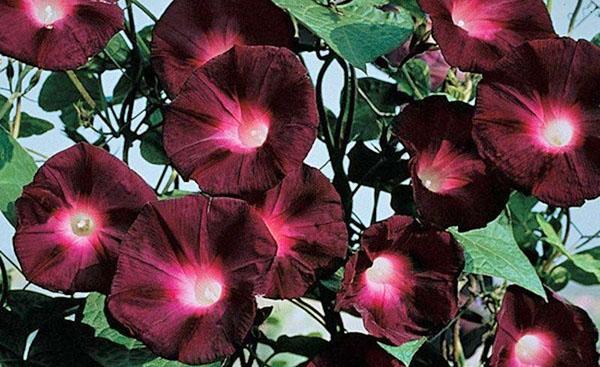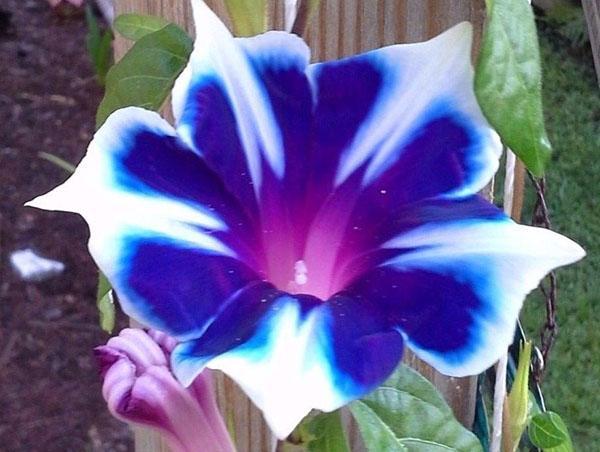We decorate our site with an unusual purple morning glory
 Surely you observed in your garden or at home in the early warm morning beautiful gramophone against the background of heart-shaped foliage. This purple morning glory is one of the fastest growing annual lianas, unpretentious to care for. You can even say that this is a kind of weed like bindweed, the decorative value of which is much higher. There are many varieties of the plant, but the most popular are purple and tricolor morning glory.
Surely you observed in your garden or at home in the early warm morning beautiful gramophone against the background of heart-shaped foliage. This purple morning glory is one of the fastest growing annual lianas, unpretentious to care for. You can even say that this is a kind of weed like bindweed, the decorative value of which is much higher. There are many varieties of the plant, but the most popular are purple and tricolor morning glory.
Ipomoea purple stars of paradise: photo and description

Morning glory develops rapidly. Literally overnight, it can twine around a small support, and in a short period the stems grow up to 3-4 m, in areas where it is warm for a long time, their length can reach 7 m.
The plant can be identified by:
- Stem. It has pubescence and curls very strongly.
- Foliage. It has a heart-shaped or ovoid-pointed shape, is located on a long petiole and is colored bright green.
- Buds. They are gramophones up to 6 cm in diameter, located on a short peduncle and painted in different colors, for example, purple, blue, blue, lilac, purple. In addition, the color can be either monochromatic or variegated. Terry and striped varieties are of great decorative value.

- Abundant flowering occurs in the last days of June and continues until frost. The peculiarity of the plant is the lifespan of the bud itself - only one day from early morning to 14-17.00 in the afternoon.
The plant is poisonous!
Photo of purple morning glory, planting and care
 Morning glory is unpretentious. Nevertheless, you need to take care of her.
Morning glory is unpretentious. Nevertheless, you need to take care of her.
Lighting and location
The plant loves light, so it should be planted in places with good daylight. It is not recommended to plant a flower in partial shade or shade, because the lack of light affects its decorative effect: the buds lose brightness, the flowering is not so abundant. The ideal location is on the south-east south or south-west windows.
Temperature regime
Ipomoea purpurea prefers warmth over cold. And frosts are completely destructive for her.
Humidity
 But this indicator is not particularly important. Yes, in a more humid atmosphere, the plant feels better than in a dry one. If there is a lack of moisture, you can simply spray the plants with a spray bottle.
But this indicator is not particularly important. Yes, in a more humid atmosphere, the plant feels better than in a dry one. If there is a lack of moisture, you can simply spray the plants with a spray bottle.
Spraying is done carefully so that drops do not fall on the buds and do not burn.
Watering
Ipomoea purple does not tolerate stagnant water. Therefore, she needs moderate watering. Overflow is destructive - the root rots and the plant dies. At the same time, in hot weather, the earthen coma should not be allowed to dry out - this will also lead to death. With the arrival of autumn, they are watered only when the soil is well dried. As soon as you see that the plant has "hung" the leaves - it needs to be watered.
The soil
The substrate for farbitis should be both nutritious and loose. These indicators significantly affect the development of the plant. The substrate should have a pH of 6-7. Moreover, it should not contain a lot of nitrogen.Otherwise, the leaf mass will grow well, and abundant flowering is not expected. If you are planting a plant in pots (for example, for seedlings), give preference to a universal soil, mix sod and deciduous soil and sand.
Top dressing
 They are carried out during the period of active growth with drugs for succulents or decorative growing plants. After the first feeding, after 2-3 weeks do a second one.
They are carried out during the period of active growth with drugs for succulents or decorative growing plants. After the first feeding, after 2-3 weeks do a second one.
The nuances of planting and leaving the purple morning glory star of paradise:
- The flower of the plant lives only one day. As a rule, it falls off on its own. But if this did not happen, it must be cut off, having previously collected the seeds.
- With the onset of the first frost, withered stems should be cut and disposed of.
- 3-4 weeks after planting, the ipomoea is supported.
- If the plant looks unsightly, pinch the tops of the stem. This will provoke the appearance of side shoots.
- In the spring, if the bush is dense, some branches are pruned, leaving 1-3 stems on each specimen.
Lowering the temperature to 5⁰C is detrimental to the plant. Therefore, planting must be carried out strictly taking into account the climate of your region.
Reproduction
 The process is carried out in a seed way by two methods.
The process is carried out in a seed way by two methods.
Seedling
Seeds of Ipomoea purple stars of paradise have a strong shell, so they are stratified before planting. Planting is carried out in plastic cups filled with a substrate (coconut fiber, vermiculite, leaf earth, peat in a ratio of 1: 1: 2: 1), after disinfecting.
 The seeds are treated with a fungicide or permanganate, washed and soaked in water for a day. 2-3 seeds are planted in each cup, to a depth of 2.5-3 cm. Watering, cover with glass or film. Germination requires a temperature of 18–20⁰C and daily airing.
The seeds are treated with a fungicide or permanganate, washed and soaked in water for a day. 2-3 seeds are planted in each cup, to a depth of 2.5-3 cm. Watering, cover with glass or film. Germination requires a temperature of 18–20⁰C and daily airing.
After 10-14 days sprouts appear.  After the second pair of leaves has grown, they are dived and transferred into a large container. After the frost has receded, the plant is transplanted to a permanent place in the ground, keeping 20-25 cm between specimens.
After the second pair of leaves has grown, they are dived and transferred into a large container. After the frost has receded, the plant is transplanted to a permanent place in the ground, keeping 20-25 cm between specimens.
Directly into the ground
Landing is carried out as soon as stable warm weather is established with a daytime temperature of 16-18⁰C, and at night not lower than 10⁰C. From above, the substrate is loosened and planted in grooves (1.5-2 cm deep) 2-3 seeds each, previously scarified. A distance of 20-25 cm should be observed between seeds.
After that everything is watered abundantly. When the shoots grow 10-15 cm in height, pinch the top to achieve branching. Further, care is carried out as usual.
Pests and diseases
 Purple morning glory flower is very weak in health. As soon as agronomic rules are violated, the plant will get sick. Most often observed:
Purple morning glory flower is very weak in health. As soon as agronomic rules are violated, the plant will get sick. Most often observed:
- White rust. It can be detected by the appearance of small rounded spots with a white bloom, due to the presence of a fungus. To eliminate the disease, the affected areas should be cut off and treated with phytosporin.
- Soft rot. It is revealed by the appearance of softness on the stems. There is only one way out - to uproot the plant and burn it.
- Anthracnose. It manifests itself, as a rule, due to the increased development of the fungus with improper watering or during a long rain period. Problems can be identified by the presence of small brown spots with yellow edging. Over time, they increase in size, interfere with the processes of photosynthesis, after which the leaf dies. It is possible to cope with the disease by removing the affected parts and stems and further treating the whips and soil with fungicidal preparations.
- Stem and root rot. They arise under the influence of the fusarium fungus. The disease is detected by the appearance of affected areas of a dark brown color with a sharp border of healthy tissues. It will no longer be possible to cure the plant. It is only removed by the roots and burned.
- Rot is black. With such a disease, depressed spots of a dark color appear on the plant with pink discharge from them.They fight by removing the affected parts, and then by spraying with fungicides.
When growing morning glory, you need to remember that there are viruses that infect the plant, but do not respond to treatment. Moreover, they are passed on to a young plant grown vegetatively.
Pests of the plant are not terrible because of their toxicity. Only spider mites and aphids can appear. Get rid of them with insecticides or infusion of garlic, soapy water.
In the world of design
 Morning glory will decorate any garden with its presence. As a rule, it is planted along the hedge, near arches, arbors for a beautiful view. A special chic is obtained when planting a mixture of colors of Ipomoea purple stars of paradise.
Morning glory will decorate any garden with its presence. As a rule, it is planted along the hedge, near arches, arbors for a beautiful view. A special chic is obtained when planting a mixture of colors of Ipomoea purple stars of paradise.
They like to plant a plant near the walls of houses to improve the microclimate in the house by shading the southern windows.
When planted near trees, the plant braids around its trunk and branches. If instead there is dried driftwood, the result will be similar to topiary. But the use of tapestries with gramophone will allow you to profitably and beautifully separate recreation area.
By decorating your garden with morning glory and showing your imagination, you can personalize your home and the landscape around it.